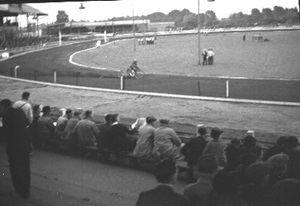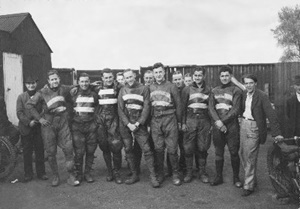
| Home | Contact Us | Articles |
| Books - DVDs | Stadia Pix | Programme Generator |
Ferry to the Speedway....by Philip Dalling
 |
|
George Greenwood in action at Nottingham White City in 1936 (Picture by the late Dick Smart) |
The banks of the River Trent in Nottingham host one of the most remarkable close concentrations of sporting activity in the UK, and possibly in the world. The famed Trent Bridge test match cricket ground, the homes of Notts County - the oldest Football League Club - and of double European Cup winners Nottingham Forest, a racecourse, greyhound track, rowing clubs, and Britain's National Water Sports Centre line the banks of the river which marks the cultural divide between north and south.
Most of the tens of thousands of people who flock to modern-day Trentside sporting occasions are probably unaware of the fact that the river bank was also once the home of Nottingham Olympic Speedway, later the White City Stadium, which was home to speedway racing before World War Two.
The river played a part in Nottingham's history. White City was almost certainly the only British speedway track to boast a race night ferry service, with fans being rowed from the south bank of the Trent virtually to the doors of the stadium!
The Nottingham Tornado Motorcyle Club used a circuit at Trent Lane, Colwick, for grass-track racing in 1928, advertising events at the `Olympic Speedway'. For the following season a dirt-track was laid down, together with safety fence, lighting and a rudimentary grandstand.
New Zealander Stewie St George acted as a consultant to the Nottingham promotion. A long season of open licence and challenge events was staged, and Nottingham also had its first taste of competitive team action - taking part - without much success - in the Northern Dirt Track League's knock-out cup competition, losing to Wombwell over two legs.
The year 1930 brought Nottingham's first taste of league speedway, with the team finishing bottom of the Southern League. Nevertheless, the track came back for more in 1931, until a spate of injuries and poor crowds forced a mid-season withdrawal.
Nottingham joined the National League for 1933, under a new promotion, managed by the experienced W R Keene. By now the basic Olympic Speedway circuit had been rebuilt as a greyhound stadium, with a main grandstand, covered terracing and other facilities. The White City side were again wooden spoonists and featured in an amazing spat with the Control Board. Nottingham withdrew from the league after claiming that inconsistent decisions over starting procedures, which came to head in a match with Wembley, were driving crowds away. The track was eventually fined but allowed to resume its season. The promoters pulled out at the end of the season and there were just a few challenge matches in 1934, and nothing in 1935.
The advent of a second division for British speedway in 1936, under the title of the Provincial League, brought Nottingham more success. The initial promotion was replaced quite early in the season by Fred Whitehead of Hackney Wick. Former Wembley star George Greenwood, who had appeared in Nottingham's colours before, boosted the team, and he won the Provincial Riders Championship at Trent Lane towards the end of the season.
 |
|
The 1937 Nottingham side l to r: Billy Lamont, Frank Hodgson, George Dykes, Fred Tuck, Sam Marsland, Tommy Bateman, and Fred Strecker (Picture courtesy of the family of Charlie Shelton) |
The following year, 1937, with Whitehead still in charge, saw Nottingham enjoy its best season results-wise. The White City men won both the Coronation Cup and the Provincial Trophy, with a side including Greenwood, Ted Bravery, Fred Tuck, Tommy Allott, Tommy Bateman, Sam Marsland, Billy Lamont and local favourities Fred Strecker and George Dykes.
Fred Whitehead pulled out in the winter of 1937-38, and Nottingham was one of former rider Arthur Westwood's four tracks in 1938 - Birmingham Hall Green, Sheffield and Leeds being the others. Westwood spread his rider assets around his three league tracks (Leeds began the year as a non-league side) and Nottingham lost Bravery and Allott to Sheffield. Crowds dwindled alarmingly, despite George Greenwood's continued form, and Westwood transferred the league side to Leeds after completing the English Speedway Trophy fixtures.
In that last season of 1938, Wilf Plant appeared in some matches for Nottingham, thus becoming the only rider to race for both Nottingham and Long Eaton. Louis Lawson, the postwar Belle Vue star who finished third in the 1949 World Final, was a spectator at White City and cut his racing teeth at grasstrack meetings promoted just outside the city by Strecker and Dykes. Another Nottingham grass-track product was Lionel Watling, who rode for Tamworth, Birmingham, Long Eaton and Leicester in the late 1940s and early 1950s.
Following World War Two there is evidence that several promoters attempted, at intervals, to bring the sport back to Nottingham, only to find the White City doors barred by the greyhound promoters. In 1947 a planning application was made to the City Council to build a speedway track on land close to the present ring-road, near the Clifton Bridge over the Trent, on a site later to be occupied by Carlton TV Studios.
White City survived until 1970 as a greyhound stadium, with the 380-yard speedway track concreted over and used to parade the dogs on wet nights. Some years later a new greyhound track was constructed in the car park of the Colwick Park Racecourse. There is a suggestion that at least one promoter approached the greyhound management about the possibility of speedway.
Local fans had to be content in post-war years with racing at Long Eaton, some nine miles west of Colwick. Nottingham raced a challenge match against Leicester Stadium at Station Road in 1930 , and the Long Eaton promotion adopted the name of Nottingham Outlaws for a couple of seasons in the 1980s.
Philip Dalling is hoping to publish an illustrated history of Nottingham Speedway in the not-too-distant future. He can be contacted at 2A Chapel Mews, Rupert Street, Ilkeston, Derbyshire, DE7 5LP (0115 930 2217) or on philip.dalling@nottingham.ac.uk
This article was first published on 10th June 2005

"I've only just found this interesting site. I met Fred Strecker and Charlie Shelton a few times in the 1960s and 70s, with Charlie living down Roseberry Avenue, a little cul-de-sac of houses at the side of Nottm Forest ground. He had been a school friend of my father, who was born in 1908. I think that Fred's real family name was Streicher, and it was Anglicised to Strecker in order to avoid anti-German hostility during WW1.
I last met him in the late 1960s when he sold a friend of mine some American side-valve vee-eight engine parts from one of his pensioned-off and derelict stock cars, stored in an overgrown yard in the Lady Bay area of West Bridgford. Charlie Shelton was in the Nottingham papers a good few years ago, when builders working on his house found a live WW2 incendiary bomb jammed in the rafters in the roof-space.
My connection to vintage speedway, which I usually call 'Dirt-Track Racing', is that I owned and restored a 1929 Scott Speedway Model, a 498cc twin-cylinder, water-cooled, two-stroke bike. Frank Varey and Allan Jefferies were VERY successful on Scotts, but no-one else seemed to have the necessary skills to handle the quirky machines. I'm currently restoring a 1929 Isle-of-Man Senior TT works Scott, but that is quite a different story, and off-topic for this site !"